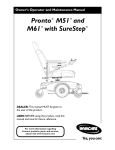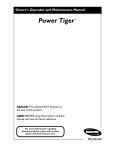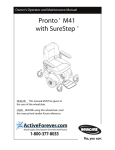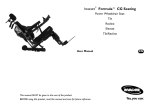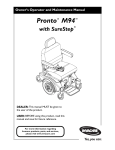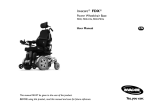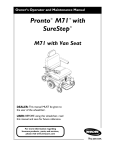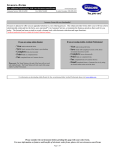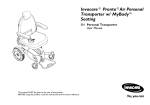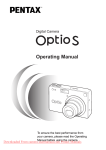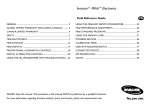Download User Manual
Transcript
Invacare® Van Seat Power Wheelchair Seat User Manual This manual MUST be given to the user of the product. BEFORE using this product, read this manual and save for future reference. EN © 2011 Invacare Corporation. All rights reserved. Republication, duplication or modification in whole or in part is prohibited without prior written permission from Invacare. Trademarks are identified by ™ and ®. All trademarks are owned by or licensed to Invacare Corporation or its subsidiaries unless otherwise noted. Invacare® Van Seat 2 Part No 1143195 CONTENTS 1 GENERAL 6 2 Symbols .................................................................................................................................................................................................................................................... 6 Warnings............................................................................................................................................................................................................................................ 6 Reference Documents .......................................................................................................................................................................................................................... 7 Limited Warranty .................................................................................................................................................................................................................................. 8 SAFETY 9 General Guidelines ................................................................................................................................................................................................................................ 9 Operation Information ....................................................................................................................................................................................................................... 10 Setup ................................................................................................................................................................................................................................................. 10 Transport......................................................................................................................................................................................................................................... 10 Repair or Service Information .................................................................................................................................................................................................... 11 Safety/Handling ..................................................................................................................................................................................................................................... 11 Pinch Points ..................................................................................................................................................................................................................................... 12 Stability and Balance ...................................................................................................................................................................................................................... 13 Footplates and Front Rigging....................................................................................................................................................................................................... 13 Reaching, Leaning and Bending - Forward. .............................................................................................................................................................................. 13 Reaching, Bending - Backward .................................................................................................................................................................................................... 14 Transferring To and From Other Seats.................................................................................................................................................................................... 14 Storage.............................................................................................................................................................................................................................................. 14 Weight Training.............................................................................................................................................................................................................................. 15 Weight Limitation .......................................................................................................................................................................................................................... 15 Electromagnetic Interference (EMI) From Radio Wave Sources.............................................................................................................................................. 15 Powered Wheelchair Electromagnetic Interference (EMI) .................................................................................................................................................. 16 Invacare® Van Seat 3 Part No 1143195 CONTENTS 3 LABEL LOCATIONS 18 4 TECHNICAL DATA 19 5 Typical Product Parameters .............................................................................................................................................................................................................. 19 Seat.................................................................................................................................................................................................................................................... 19 USAGE 20 6 A Note About Drive Lock-Out........................................................................................................................................................................................................ 20 Operating Powered Seating Systems............................................................................................................................................................................................... 21 Using the Powered Seating Switch ............................................................................................................................................................................................ 22 Using the MK6i SPJ+ w/ACC Joystick....................................................................................................................................................................................... 22 Using the CMPJ+ Joystick ............................................................................................................................................................................................................ 24 Programmable Mono Ports 1 and 2 with External Mode Switch ....................................................................................................................................... 26 Remote On/Off Switch................................................................................................................................................................................................................. 26 Mode Switch ................................................................................................................................................................................................................................... 27 Memory Card Slot......................................................................................................................................................................................................................... 27 About Front Riggings........................................................................................................................................................................................................................... 27 Installing/Removing Front Riggings................................................................................................................................................................................................... 28 Installing............................................................................................................................................................................................................................................ 28 Removing ......................................................................................................................................................................................................................................... 28 Raising/Lowering Elevating Front Riggings ..................................................................................................................................................................................... 29 Removing/Installing the Manual Center Mount Footrest............................................................................................................................................................ 29 Removing ......................................................................................................................................................................................................................................... 29 Installing............................................................................................................................................................................................................................................ 29 ADJUSTMENT 30 Footrest Height Adjustment ............................................................................................................................................................................................................. 30 PHWH93 ......................................................................................................................................................................................................................................... 31 PH904A and PHAL4A................................................................................................................................................................................................................... 31 Adjusting the Height of the Manual Center Mount Footrest .................................................................................................................................................... 32 Part No 1143195 4 Invacare® Van Seat CONTENTS 7 Adjusting the Angle of the Manual Center Mount Footrest...................................................................................................................................................... 33 Adjusting the Footplate Angle........................................................................................................................................................................................................... 34 Adjusting the Tension of the Flip Up Footplate............................................................................................................................................................................ 34 Adjusting Armrests.............................................................................................................................................................................................................................. 35 Angle ................................................................................................................................................................................................................................................. 35 Height ............................................................................................................................................................................................................................................... 35 Adjusting the Back Angle ................................................................................................................................................................................................................... 36 Adjusting the Headrest....................................................................................................................................................................................................................... 36 SETUP/MAINTENANCE 37 Setup/Delivery Inspection .................................................................................................................................................................................................................. 37 User/Attendant Inspection Checklists ............................................................................................................................................................................................ 38 Inspect/Adjust Weekly.................................................................................................................................................................................................................. 38 Inspect/Adjust Monthly................................................................................................................................................................................................................. 38 Inspect/Adjust Periodically........................................................................................................................................................................................................... 39 Service Inspection ................................................................................................................................................................................................................................ 39 Six Month Inspection .................................................................................................................................................................................................................... 40 Troubleshooting ................................................................................................................................................................................................................................... 40 Replacing Heel Loops.......................................................................................................................................................................................................................... 41 Adjusting/Replacing Telescoping Front Rigging Supports ........................................................................................................................................................... 42 Invacare® Van Seat 5 Part No 1143195 1 GENERAL 1 General 1.1 Symbols Warnings Signal words are used in this manual and apply to hazards or unsafe practices which could result in personal injury or property damage. See the information below for definitions of the signal words. DANGER WARNING CAUTION ! Danger indicates an imminently hazardous situation which, if not avoided, will result in death or serious injury. Warning indicates a potentially hazardous situation which, if not avoided, could result in death or serious injury. Caution indicates a potentially hazardous situation which, if not avoided, may result in property damage or minor injury or both. IMPORTANT Indicates a hazardous situation that could result in damage to property if it is not avoided. Gives useful tips, recommendations and information for efficient, trouble-free use. Invacare® Van Seat 6 Part No 1143195 1 GENERAL 1.2 Reference Documents WARNING Refer to wheelchair base owner’s manual for additional safety and operation information. Refer to the table below for part numbers of additional documents which are referenced in this manual. MANUAL PART NUMBER MK6i™ Electronics Programming Guide Part No 1143195 1141471 7 Invacare® Van Seat 1 GENERAL 1.3 Limited Warranty PLEASE NOTE: THE WARRANTY BELOW HAS BEEN DRAFTED TO COMPLY WITH FEDERAL LAW APPLICABLE TO PRODUCTS MANUFACTURED AFTER JULY 4, 1975. This warranty is extended only to the original purchaser who purchases this product within any country excluding CANADA when new and unused from Invacare or a dealer. This warranty is not extended to any other person or entity and is not transferable or assignable to any subsequent purchaser or owner. Coverage under this warranty will end upon any such subsequent sale or other transfer of title to any other person. For product purchased in Canada, please refer to the Canada Limited Warranty. This warranty gives you specific legal rights and you may also have other legal rights which vary from state to state. Invacare warrants the seat frame to be free from defects in materials and workmanship for a period of three (3) years from the date of purchase from Invacare or a dealer, with a copy of the seller’s invoice required for coverage under this warranty. Invacare warrants all remaining components (excluding all upholstered materials and padded materials) to be free from defects in materials and workmanship for a period of one (1) year from the date of purchase from Invacare or a dealer, with a copy of the seller’s invoice required for coverage under this warranty. If within such warranty periods any such product component shall be proven to be defective, the product component shall be repaired or replaced, at Invacare's option. This warranty does not include any labor or shipping charges incurred in replacement part installation or repair of any such product. Invacare's sole obligation and your exclusive remedy under this warranty shall be limited to such repair and/or replacement. For warranty service, please contact the dealer from whom you purchased your Invacare product. In the event you do not receive satisfactory warranty service, please write directly to Invacare at the address on the bottom of the back cover. Provide dealer's name address, date of purchase, indicate nature of the defect and, if the product is serialized, indicate the serial number. Do not return products to our factory without our prior consent. LIMITATIONS AND EXCLUSIONS: THE FOREGOING WARRANTY SHALL NOT APPLY TO SERIAL NUMBERED PRODUCTS IF THE SERIAL NUMBER HAS BEEN REMOVED OR DEFACED, PRODUCTS SUBJECT TO NEGLIGENCE, ACCIDENT, IMPROPER OPERATION, MAINTENANCE OR STORAGE, COMMERCIAL OR INSTITUTIONAL USE, PRODUCTS MODIFIED WITHOUT INVACARE'S EXPRESS WRITTEN CONSENT (INCLUDING, BUT NOT LIMITED TO, MODIFICATION THROUGH THE USE OF UNAUTHORIZED PARTS OR ATTACHMENTS); PRODUCTS DAMAGED BY REASON OF REPAIRS MADE TO ANY COMPONENT WITHOUT THE SPECIFIC CONSENT OF INVACARE, OR TO A PRODUCT DAMAGED BY CIRCUMSTANCES BEYOND INVACARE'S CONTROL, AND SUCH EVALUATION WILL BE SOLELY DETERMINED BY INVACARE. THE WARRANTY SHALL NOT APPLY TO PROBLEMS ARISING FROM NORMAL WEAR AND TEAR OR FAILURE TO ADHERE TO THE PRODUCT INSTRUCTIONS. A CHANGE IN OPERATING NOISE, PARTICULARLY RELATIVE TO MOTORS AND GEARBOXES DOES NOT CONSTITUTE A FAILURE OR DEFECT AND WILL NOT BE REPAIRED; ALL DEVICES WILL EXHIBIT CHANGES IN OPERATING NOISE DUE TO AGING. THE FOREGOING EXPRESS WARRANTY IS EXCLUSIVE AND IN LIEU OF ANY OTHER WARRANTIES WHATSOEVER, WHETHER EXPRESS OR IMPLIED, INCLUDING THE IMPLIED WARRANTIES OF MERCHANTABILITY AND FITNESS FOR A PARTICULAR PURPOSE, AND THE SOLE REMEDY FOR VIOLATIONS OF ANY WARRANTY WHATSOEVER, SHALL BE LIMITED TO REPAIR OR REPLACEMENT OF THE DEFECTIVE PRODUCT PURSUANT TO THE TERMS CONTAINED HEREIN. THE APPLICATION OF ANY IMPLIED WARRANTY WHATSOEVER SHALL NOT EXTEND BEYOND THE DURATION OF THE EXPRESS WARRANTY PROVIDED HEREIN AND INVACARE SHALL NOT BE LIABLE FOR ANY CONSEQUENTIAL OR INCIDENTAL DAMAGES WHATSOEVER; SOME STATES DO NOT ALLOW THE EXCLUSION OR LIMITATION OF INCIDENTAL OR CONSEQUENTIAL DAMAGE, OR LIMITATION OF HOW LONG AN IMPLIED WARRANTY LASTS, SO THE ABOVE EXCLUSION AND LIMITATION MAY NOT BE APPLICABLE. THIS WARRANTY SHALL BE EXTENDED TO COMPLY WITH STATE/PROVINCIAL LAWS AND REQUIREMENTS. Invacare® Van Seat 8 Part No 1143195 2 SAFETY 2 Safety The safety section contains important information for the safe operation and use of this product. 2.1 General Guidelines ! WARNING DO NOT use this product or any available optional equipment without first completely reading and understanding these instructions and any additional instructional material such as owner’s manuals, service manuals or instruction sheets supplied with this product or optional equipment. If you are unable to understand the warnings, cautions or instructions, contact a healthcare professional, dealer or technical personnel before attempting to use this equipment - otherwise, injury or damage may occur. Procedures other than those described in this manual must be performed by a qualified technician. ACCESSORIES WARNINGS Invacare products are specifically designed and manufactured for use in conjunction with Invacare accessories. Accessories designed by other manufacturers have not been tested by Invacare and are not recommended for use with Invacare products. EXTREME care should be exercised when using oxygen in close proximity to electric circuits and other combustible materials. Contact your oxygen supplier for instruction in the use of oxygen. NOTICE THE INFORMATION CONTAINED IN THIS DOCUMENT IS SUBJECT TO CHANGE WITHOUT NOTICE. Check all parts for shipping damage and test before using. In case of damage, DO NOT use. Contact Invacare/Carrier for further instruction. As a manufacturer of wheelchairs, Invacare endeavors to supply a wide variety of wheelchairs to meet many needs of the end user. However, final selection of the type of wheelchair to be used by an individual rests solely with the user and his/her healthcare professional capable of making such a selection. Invacare highly recommends working with a certified rehab technology supplier and/or a member of NRRTS or RESNA. Part No 1143195 9 Invacare® Van Seat 2 SAFETY 2.2 Operation Information Setup WARNING A qualified technician must perform the initial set up of this wheelchair. Also, a qualified technician must perform all procedures in the service manual. Performance adjustments should only be made by professionals of the healthcare field or persons fully conversant with this process and the driver's capabilities. Incorrect settings could cause injury to the driver, bystanders, damage to the wheelchair and to surrounding property. After the wheelchair has been set-up/adjusted, check to make sure that the wheelchair performs to the specifications entered during the set-up procedure. If the wheelchair does not perform to specifications, turn the wheelchair Off immediately and reenter set-up specifications. Repeat this procedure until the wheelchair performs to specifications. Transport WARNING DO NOT operate on roads, streets or highways. WHEELCHAIR TIE-DOWN RESTRAINTS AND SEAT RESTRAINTS As of this date, the Department of Transportation has not approved any tie-down systems for transportation of a user while in a wheelchair, in a moving vehicle of any type. It is Invacare’s position that users of wheelchairs should be transferred into appropriate seating in vehicles for transportation and use be made of the restraints made available by the auto industry. Invacare cannot and does not recommend any wheelchair transportation systems. STAIRWAYS AND ESCALATORS DO NOT use an escalator to move a wheelchair between floors. Serious bodily injury may occur. DO NOT attempt to lift the wheelchair by any removable (detachable) parts. Lifting by means of any removable (detachable) parts of a wheelchair may result in injury to the user or damage to the wheelchair. Invacare® Van Seat 10 Part No 1143195 2 SAFETY Repair or Service Information 2.3 WARNING Except for programming, DO NOT service or adjust the wheelchair while occupied, unless otherwise noted. Before adjusting, repairing or servicing the wheelchair, ALWAYS turn the wheelchair power Off, otherwise, injury or damage may occur. Wheelchairs should be examined during maintenance for signs of corrosion (water exposure, incontinence, etc.). Electrical components damaged by corrosion should be replaced immediately. Wheelchairs that are used by incontinent users and/or are frequently exposed to water may require replacement of electrical components more frequently. DO NOT overtighten hardware attaching to the frame. This could cause damage to the frame tubing. Safety/Handling WARNING Refer to wheelchair base owner’s manual for additional safety and operation information. The seat positioning strap is a positioning belt ONLY. It is not designed for use as a safety device withstanding high stress loads such as auto or aircraft safety straps. If signs of wear appear, strap MUST be replaced IMMEDIATELY. DO NOT leave the power button On when entering or exiting your wheelchair. DO NOT go UP or DOWN ramps or traverse slopes greater than 9°. NEVER leave an unoccupied wheelchair unattended on an incline. Invacare strongly recommends proceeding down ramps or slopes at half speed or slower and to avoid hard braking or sudden stops. DO NOT leave elevating legrests in the fully extended position when proceeding down ramps or slopes. DO NOT attempt to move up or down an incline with water, ice or oil film. DO NOT attempt to drive over curbs or obstacles. Doing so may cause your wheelchair to turn over and cause bodily harm or damage to the wheelchair. Part No 1143195 11 Invacare® Van Seat 2 SAFETY WARNING DO determine and establish your particular safety limits by practicing bending, reaching and transferring activities in the presence of a qualified healthcare professional before attempting active use of the wheelchair. DO NOT attempt to reach objects if you have to move forward in your seat. Always shift your weight in the direction you are turning. Do not shift your weight in the opposite direction of the turn. Shifting your weight in the opposite direction of the turn may cause the inside drive wheel to lose traction and the wheelchair to tip over. DO NOT shift your weight or sitting position toward the direction you are reaching as the wheelchair and/or seating system (if any) may tip over. ALWAYS keep hands and fingers clear of moving parts to avoid injury. DO NOT use with a broken or missing joystick knob. DO NOT use if joystick does not spring back to the neutral position or becomes sticky or sluggish. DO NOT use if joystick boot is torn or damaged. ALWAYS check foam grips for looseness before using the wheelchair. If loose, contact a qualified technician for instructions. Pinch Points WARNING Pinch Point DO NOT store or place items under the seat. Pinch point may occur when adjusting the arm angle position. Invacare® Van Seat 12 Part No 1143195 2 SAFETY Stability and Balance WARNING ALWAYS wear your seat positioning strap. The seat positioning strap is a positioning strap ONLY. It is not designed for use as a safety device withstanding high stress loads such as auto or aircraft safety straps. If signs of wear appear, strap MUST be replaced IMMEDIATELY. With regard to seat/chest positioning straps - it is the obligation of the DME dealer, therapists and other healthcare professionals to determine if a seat/chest positioning strap is required to ensure the safe operation of this equipment by the user. To determine and establish your particular safety limits, practice use of this product on various sloping surfaces in the presence of a qualified healthcare provider before attempting active use of this wheelchair. Other general warnings listed within this document also apply. DO NOT stand on the frame of the wheelchair. Footplates and Front Rigging WARNING DO NOT use the footplates as a platform. DO NOT stand on the footplates/footboard. When getting in or out of the wheelchair, make sure that the footplates are in the upward position or swing footrests towards the outside of the wheelchair. When determining the depth of the telescoping front frame tubes, make sure the rear of the footrests do not interfere with the movement of the front casters. Otherwise damage to the wheelchair may result or may impede proper operation. Reaching, Leaning and Bending - Forward. WARNING DO NOT attempt to reach objects if you have to move forward in the seat or pick them up from the floor by reaching down between your knees. Part No 1143195 13 Invacare® Van Seat 2 SAFETY Reaching, Bending - Backward WARNING DO NOT lean over the top of the back upholstery. This will change your center of gravity and may cause you to tip over. Transferring To and From Other Seats WARNING ALWAYS turn the wheelchair power OFF and engage the motor locks/clutches to prevent the wheels from moving before attempting to transfer in or out of the wheelchair. Also make sure every precaution is taken to reduce the gap distance. Align both casters parallel with the object you are transferring onto. Storage WARNING Avoid storing or using the wheelchair near open flame or combustible products. Serious injury or damage to property may result. DO NOT use if the joystick boot is torn or cracked. If the joystick boot becomes torn or cracked, replace IMMEDIATELY. RAIN TEST Invacare has tested its power wheelchairs in accordance with ISO 7176 “Rain Test”. This provides the end user or his/her attendant sufficient time to remove his/her power wheelchair from a rain storm and retain wheelchair operation. DO NOT leave power wheelchair in a rain storm of any kind. DO NOT use power wheelchair in a shower. DO NOT leave power wheelchair in a damp area for any length of time. Direct exposure to rain or dampness will cause the wheelchair to malfunction electrically and mechanically; may cause the wheelchair to prematurely rust or may damage the upholstery. Invacare® Van Seat 14 Part No 1143195 2 SAFETY Weight Training WARNING Invacare DOES NOT recommend the use of its wheelchairs as a weight training apparatus. Invacare wheelchairs have NOT been designed or tested as a seat for any kind of weight training. If occupant uses said wheelchair as a weight training apparatus, INVACARE SHALL NOT BE LIABLE FOR BODILY INJURY AND THE WARRANTY IS VOID. Weight Limitation 2.4 WARNING Refer to Typical Product Parameters on page 19 and Typical Product Parameters in the manual shipped with the wheelchair base to determine the weight limit (total combined weight of user and any attachments) of your wheelchair model. DO NOT exceed the limit - otherwise, injury or damage may result. Electromagnetic Interference (EMI) From Radio Wave Sources Powered wheelchairs and motorized scooters (in this text, both will be referred to as powered wheelchairs) may be susceptible to electromagnetic interference (EMI), which is interfering electromagnetic energy (EM) emitted from sources such as radio stations, TV stations, amateur radio (HAM) transmitters, two way radios, and cellular phones. The interference (from radio wave sources) can cause the powered wheelchair to release its brakes, move by itself, or move in unintended directions. It can also permanently damage the powered wheelchair's control system. The intensity of the interfering EM energy can be measured in volts per meter (V/m). Each powered wheelchair can resist EMI up to a certain intensity. This is called its "immunity level." The higher the immunity level, the greater the protection. At this time, current technology is capable of achieving at least a 20 V/m immunity level, which would provide useful protection from the more common sources of radiated EMI. There are a number of sources of relatively intense electromagnetic fields in the everyday environment. Some of these sources are obvious and easy to avoid. Others are not apparent and exposure is unavoidable. However, we believe that by following the warnings listed below, your risk to EMI will be minimized. The sources of radiated EMI can be broadly classified into three types: 1. Hand-held Portable transceivers (transmitters-receivers with the antenna mounted directly on the transmitting unit. Examples include: citizens band (CB) radios, “walkie talkie”, security, fire and police transceivers, cellular telephones, and other personal communication devices). Some cellular telephones and similar devices transmit signals while they are ON, even when not being used. Part No 1143195 15 Invacare® Van Seat 2 SAFETY 2. 3. Medium-range mobile transceivers, such as those used in police cars, fire trucks, ambulances and taxis. These usually have the antenna mounted on the outside of the vehicle; and Long-range transmitters and transceivers, such as commercial broadcast transmitters (radio and TV broadcast antenna towers) and amateur (HAM) radios. Other types of hand-held devices, such as cordless phones, laptop computers, AM/FM radios, TV sets, CD players, cassette players, and small appliances, such as electric shavers and hair dryers, so far as we know, are not likely to cause EMI problems to your powered wheelchair. Powered Wheelchair Electromagnetic Interference (EMI) Because EM energy rapidly becomes more intense as one moves closer to the transmitting antenna (source), the EM fields from hand-held radio wave sources (transceivers) are of special concern. It is possible to unintentionally bring high levels of EM energy very close to the powered wheelchair's control system while using these devices. This can affect powered wheelchair movement and braking. Therefore, the warnings listed below are recommended to prevent possible interference with the control system of the powered wheelchair. Electromagnetic interference (EMI) from sources such as radio and TV stations, amateur radio (HAM) transmitters, two-way radios, and cellular phones can affect powered wheelchairs and motorized scooters. FOLLOWING THE WARNINGS LISTED BELOW SHOULD REDUCE THE CHANCE OF UNINTENDED BRAKE RELEASE OR POWERED WHEELCHAIR MOVEMENT WHICH COULD RESULT IN SERIOUS INJURY. Invacare® Van Seat 16 Part No 1143195 2 SAFETY WARNING 1) DO NOT operate hand-held transceivers (transmitters receivers), such as citizens band (CB) radios, or turn ON personal communication devices, such as cellular phones, while the powered wheelchair is turned ON; 2) Be aware of nearby transmitters, such as radio or TV stations, and try to avoid coming close to them; 3) If unintended movement or brake release occurs, turn the powered wheelchair OFF as soon as it is safe; 4) Be aware that adding accessories or components, or modifying the powered wheelchair, may make it more susceptible to EMI (NOTE: There is no easy way to evaluate their effect on the overall immunity of the powered wheelchair); and 5) Report all incidents of unintended movement or brake release to the powered wheelchair manufacturer, and note whether there is a source of EMI nearby. Important Information 1) 20 volts per meter (V/m) is a generally achievable and useful immunity level against EMI (as of May 1994) (the higher the level, the greater the protection); 2) This device has been tested to a radiated immunity level of 20 volts per meter. 3) The immunity level of the product is unknown. Modification of any kind to the electronics of this scooter as manufactured by Invacare may adversely affect the EMI immunity levels. Part No 1143195 17 Invacare® Van Seat 3 LABEL LOCATIONS 3 Label Locations Refer to the owner’s manual shipped with wheelchair base for additional labels located on the wheelchair base. Weight Capacity Label located here Invacare® Van Seat 18 Part No 1143195 4 TECHNICAL DATA 4 Technical Data 4.1 Typical Product Parameters Seat Based on an 18 inch deep van seat. 18 INCH WIDE VAN SEAT 20 INCH WIDE VAN SEAT 22 INCH WIDE VAN SEAT Seat Width: 18 inches Seat Depth: 16 to 18 inches Seat-to-Floor Height 20 inches 22 inches 18 to 20 inches 20 to 22 inches 22½ to 23½ inches (Cushion not compressed) Overall Width Without Joystick: 25-7/8 inches Overall Height: 36 to 49¼ inches Overall Length with Footboard Folded 39 inches Back Height without Headrest: 18 inches Back Angle Range Semi-Recline: Full Recline 35° to 115° 35° to 170° Armrests: Adjustable Angle Depth and Width Upholstery Options: Grey Vinyl, Grey Cloth, Tan Vinyl Footrests/Legrests: Flip Up, Depth and Height Adjustable, Footboard, Swingaway Front Rigging, Elevating Legrest Incline Capability Part No 1143195 9° 19 Invacare® Van Seat 5 USAGE 5 Usage 5.1 WARNING After ANY adjustments, repair or service and before use, make sure that all attaching hardware is tightened securely otherwise injury or damage may result. Set-up of the Electronic Control Unit is to be performed only by a qualified technician. The final adjustments of the controller may affect other activities of the wheelchair. Damage to the equipment could occur under these circumstances. A Note About Drive Lock-Out WARNING NEVER operate the wheelchair while the back is in any reclined/back angle position over 20° relative to the vertical position. If the drive lock-out does not stop the wheelchair from operating in a recline/back angle position over 20° relative to the vertical position, DO NOT operate the wheelchair. DO NOT attempt to adjust the drive lock-out. Have the wheelchair serviced by a qualified technician. The wheelchair user MUST have a clear line of sight to drive safely. On initial chair delivery and after adjusting the back angle or drive lock-out switch, recline the seat back to the farthest driving position immediately before drive lock-out engages and ensure there is a clear line of sight present in which to drive the wheelchair. If a clear line of sight is not present, have the back angle repositioned or readjust the lockout angle such that safe driving with a clear line of sight is achieved. Otherwise injury or damage may occur. One of the following will occur when the drive lock-out feature has been activated: • CMPJ™+ Joysticks Only - TILT WARNING or SPM Controller Inhibited displays on the joystick or display unit. • SPJ™+ Joysticks Only - Left to right chase alternating with a steady display. Drive lock-out is a feature designed to prevent the wheelchair from being driven after the seating system has been reclined beyond 20°* relative to the vertical position. The back can be positioned at a 10° relative offset to the seat base, thereby resulting in a back angle potential of 30° before which the drive lock-out is activated. This may affect the wheelchair user’s line of sight while driving. Make sure the wheelchair user can see properly to ensure safe driving. Invacare® Van Seat 20 Part No 1143195 5 USAGE 5.2 *20° back angle can be any combination of recline, back angle and/or surface angle. Refer to Typical Product Parameters on page 19 for recline angle ranges. Operating Powered Seating Systems GENERAL WARNINGS Refer to A Note About Drive Lock-Out on page 20 before performing this procedure. Pinch points may occur when returning the seat from any tilted position to the full upright position or when lowering the elevating seat. Make sure the hands and body of both the occupant and attendants/bystanders are clear of all pinch points before returning the seat to the full upright position or lowering the elevating seat. NEVER operate the wheelchair while the back is in any tilted/back angle position over 20° relative to the vertical position. If the drive lock-out does not stop the wheelchair from operating in a tilt/back angle position over 20° relative to the vertical position, DO NOT operate the wheelchair. DO NOT attempt to adjust the drive lock-out. Have the wheelchair serviced by a qualified technician. Use caution when driving in a tilted position. DO NOT operate the seating system while on an incline. DO NOT operate seating system while the wheelchair is moving. DO NOT operate the tilt function near or under a fixed object such as a table or desk. ACTUATOR CONTROL WARNING Use only the actuator controls listed in the following chart to activate the tilt/recline/elevate functions. DO NOT USE any other actuator controls. Such devices may result in excess heating and cause damage to the actuator and associated wiring and could cause a fire, death, physical injury or property damage. If such devices are used, Invacare shall not be liable and the limited warranty is void. Part No 1143195 21 Invacare® Van Seat 5 USAGE SYSTEM TYPE JOYSTICK POWERED SEATING CONTROL 4 POLE MOTOR SWITCH OPTION Single Actuator (Elevate Only) MK6i SPJ+ w/PSS Powered Seating Switch THROUGH THE JOYSTICK (TTJ) No MK6i SPJ+ w/ACC Yes CMPJ+ Yes with SANODE This procedure only applies to wheelchairs with Formula PTO Plus or Power Tilt Only seating systems. Using the Powered Seating Switch The powered seating switch can be used with all joysticks. The powered seating switch will alternate functions (increase tilt angle, decrease tilt angle) after it has been released for a minimum of three seconds. 1. Make sure the wheelchair is on a level surface. 2. Press the powered seating switch once to activate the actuator. 3. Press the powered seating switch again (after at least 3 seconds) to activate the actuator in the opposite direction. Using the MK6i SPJ+ w/ACC Joystick For this procedure, refer to FIGURE 1 on page 23. 1. Make sure the wheelchair is on a level surface. 2. Press the mode button to switch from driving mode to tilt mode. Invacare® Van Seat 22 Part No 1143195 5 USAGE 3. The LED will light up with a circle around it. Move the joystick: • Forward - To raise the seat (elevate up). • Backward - To lower the seat (elevate down). Joystick Information Gauge Display On/Off Button Decrease Speed Button (Tortoise) GREEN LED Mode Button* Speedometer Increase Speed Button (Hare) Service Indicator Additional Input for Powered Seating Switch Charger/ Programming Input Active (If Programed) *The mode button is only present on SPJ+ w/ACC joystick. FIGURE 1 Using the MK6i SPJ+ w/ACC Joystick Part No 1143195 23 Invacare® Van Seat 5 USAGE Using the CMPJ+ Joystick 1. For this procedure, refer to FIGURE 2 on page 25. Make sure the wheelchair is on a level surface. 2. Select a drive that has the Actuator Control Switch Mode icon 3. Select the Actuator Control Switch Mode icon (Detail “A”). 4. Four of the following icons will display when Actuator Control Switch Mode is selected: displayed. The location of the icons indicates the joystick direction or quadrant (Detail “B”). ICON DESCRIPTION Elevate Operations Combined Power Leg Operations Right Leg Operations Left Leg Operations No Icons 5. No powered seating operation has been programmed for this quadrant. The three icons indicate up/down, up or down, respectively. Select the desired operation using the joystick or an equivalent switch. Invacare® Van Seat 24 Part No 1143195 5 USAGE While operating the powered seating system, the selected icon will display on the screen along with text indicating the current operation (Detail “C”). CMPJ+ Joystick Switches and Indicators Charger/Programming Input (Front of Joystick) Drive Select Toggle Switch Joystick Programmable Mono Port 1/2 or External Mode Switch DETAIL “A” - ACTUATOR CONTROL SWITCH MODE EXAMPLE SCREEN Memory Card Slot Elevate Down Icon (Move the joystick down to use this function) LCD Display Mode Switch Operation Icons Speed Control Knob DETAIL “B” - EXAMPLE SCREEN DURING POWERED SEATING OPERATION Remote On/ Off Input Icon To Controller Text FIGURE 2 Using the CMPJ+ Joystick Part No 1143195 25 Invacare® Van Seat 5 USAGE Programmable Mono Ports 1 and 2 with External Mode Switch The programmable mono port with external mode switch input is located at the rear of the joystick on the left side. The programmable mono port input offers the choice of three options: • Remote drive select • Remote stop/mode (reset) input • Single actuator input The single switch functions operate through mono port 1. An optional y-cable allows a second programmable function through mono port 2. Remote Stop Switch The remote reset switch may be used to stop the wheelchair if the wheelchair is in motion. The remote reset switch also functions in the same way as the joystick mode switch when the wheelchair is not in motion. Refer to Mode Switch on page 27. Remote On/Off Switch The remote On/Off switch input is located at the rear of the joystick on the right side and allows the power switch to be operated by an ability switch (normally open momentary switch with mono plug). To use the remote On/Off feature, the Drive Select/On/Off switch must be in the On position. Each activation of the ability switch will alternately turn the joystick On or Off. Invacare® Van Seat 26 Part No 1143195 5 USAGE Mode Switch The mode switch is used to select the operating mode for the wheelchair. The mode switch is located on the joystick. A mode switch is needed whenever any of the following operating modes are programmed: • Environmental Controls (ECU 1, ECU 2, ECU 3, ECU 4)* • 3 Speed Mode in Digital 3 Speed (Slow, Medium, Full) • Sleep Mode • RIM Mode* • Remote Drive Selection Mode* • Tilt/Recline Mode* • Information Center Display Selection (does not require Reset activation at power up) If any of the above modes are selected, the control will require activation of the switch immediately after the power switch is turned On in order to enter the drive mode. The second line of the LCD will display - PRESS RESET. *In these modes, Standby Select allows the reset switch to be bypassed for users unable to activate the switch. Memory Card Slot The memory card slot is used with the basic or professional memory card for saving or reading wheelchair parameters. 5.3 About Front Riggings WARNING While the wheelchair is moving, minimum ground clearance for the front rigging is three inches. If the wheelchair is not moving, the front rigging MUST maintain a minimum of one inch ground clearance - otherwise personal injury and damage may result. DO NOT use the footplates as a platform. DO NOT stand on the footplates/footboard. When getting in or out of the wheelchair, make sure that the footplates are in the upward position or swing footrests towards the outside of the wheelchair. Part No 1143195 27 Invacare® Van Seat 5 USAGE 5.4 Installing/Removing Front Riggings CAUTION If front riggings are used, then the seat MUST be adjusted to the highest mounting position - otherwise damage may occur. Installing 1. If necessary, remove the footboard. Refer to owner’s manual shipped with the wheelchair. 2. Turn front rigging to the side (open footplate is perpendicular to wheelchair) and position mounting holes in the front rigging hinge plates with hinge pins on the wheelchair frame. 3. Install the front rigging hinge plates onto the hinge pins on the wheelchair frame. 4. Push the front rigging towards the inside of the wheelchair until it locks into place. 5. Telescoping Front Rigging Support The footplate will be on the inside of the wheelchair when locked in place. Hinge Pins Repeat STEPS 1-4 for opposite side of wheelchair. Front Rigging Release Lever Removing 1. 2. 3. Push the front rigging release lever inward and rotate the footrest out. Lift up on front rigging and remove from the wheelchair. Repeat STEPS 1-2 for opposite side of wheelchair. Invacare® Van Seat Front Rigging Hinge Plate FIGURE 3 28 Installing/Removing Front Riggings Part No 1143195 5 USAGE 5.5 1. Raising/Lowering Elevating Front Riggings Perform one of the following: • Raising - Pull back on the release lever and raise front rigging to the desired height. • Release Lever Lowering - Support front rigging with one hand away from the release lever. Push release lever downward with other hand. FIGURE 4 5.6 Removing/Installing the Manual Center Mount Footrest Removing 1. 2. Raising/Lowering Elevating Front Riggings Remove the rigging pivot pin that secures the footrest to the mounting bracket of the seat frame. Hold the footrest with one hand and engage the release lever with the other while simultaneously pulling the center mount footrest out of the mounting bracket of the seat frame. Release lever located towards the front or center of seat frame. Installing 1. 2. Engage the release lever with one hand, hold the center mount footrest with the other, and insert the center mount footrest into the mounting bracket of the seat frame. Reinstall the rigging pivot pin to secure the center mount footrest to the mounting bracket of the seat frame. Rigging Pivot Pin Seat Frame Mounting Bracket Center Mount Footrest FIGURE 5 Part No 1143195 29 Removing/Installing the Manual Center Mount Footrest Invacare® Van Seat 6 ADJUSTMENT 6 Adjustment WARNING After ANY adjustments, repair or service and before use, make sure that all attaching hardware is tightened securely - otherwise injury or damage may result. While the wheelchair is moving, minimum ground clearance for the front rigging is three inches. If the wheelchair is not moving, the front rigging MUST maintain a minimum of one inch ground clearance - otherwise personal injury and damage may result. DO NOT use the footplates as a platform. DO NOT stand on the footplates/footboard. When getting in or out of the wheelchair, make sure that the footplates are in the upward position or swing footrests towards the outside of the wheelchair. CAUTION As with any vehicle, the wheels and tires should be checked periodically for cracks and wear, and should be replaced. 6.1 Footrest Height Adjustment WARNING While the wheelchair is moving, minimum ground clearance for the front rigging is three inches. If the wheelchair is not moving, the front rigging MUST maintain a minimum of one inch ground clearance - otherwise personal injury and damage may result. Invacare® Van Seat 30 Part No 1143195 6 ADJUSTMENT PHWH93 1. Remove any accessory from the footrest(s). 2. 3. 4. 5. 6. 7. 8. Lay the footrest on a flat surface to simplify this procedure. Remove the footrest from the wheelchair. Refer to Installing/ Removing Front Riggings on page 28. Remove the hex bolt, washers and locknut that secure the lower footrest assembly to the upper footrest support (FIGURE 1). Reposition the lower footrest to the desired height. Reinstall the hex bolt, washers and locknut that secure the lower footrest to the footrest support and tighten securely. Repeat STEPS 1-5 for the opposite wheelchair footrest, if necessary. Reinstall the footrest(s) onto the wheelchair. Refer to Installing/ Removing Front Riggings on page 28. Reinstall any accessory onto the footrest(s). Footrest Support Coved Washer Locknut Coved Washer Hex Bolt Lower Footrest FIGURE 1 Footrest Height Adjustment - PHWH93 PH904A and PHAL4A 1. 2. 3. 4. Loosen, but DO NOT remove, the lug bolt and locknut that secure the lower footrest to the footrest support. Reposition the lower footrest to the desired height. Securely tighten the lug bolt and locknut that secure the lower footrest to the footrest support. Repeat STEPS 1-3 for the opposite side of the wheelchair footrest, if necessary. Footrest Support Lower Footrest Lug Bolt PH904A style front rigging shown. PHAL4A front rigging adjusts the same way. Part No 1143195 Locknut FIGURE 2 31 Footrest Height Adjustment Invacare® Van Seat 6 ADJUSTMENT 6.2 Adjusting the Height of the Manual Center Mount Footrest 1. 2. 3. 4. WARNING While the wheelchair is moving, minimum ground clearance for the front rigging is three inches. If the wheelchair is not moving, the front rigging MUST maintain a minimum of one inch ground clearance - otherwise personal injury and damage may result. PINCH POINT EXISTS BETWEEN CENTER MOUNT FOOTREST AND CASTERS - There is limited clearance between center mount footrest and casters. The user’s feet MUST remain on the center mount footrest while operating the wheelchair. If the user’s feet are allowed to rest off the side of the center mount footrest they may come in contact with the caster possibly resulting in injury. Remove the two mounting screws that secure the button head cleat to the extension housing. Adjust the footrest extension tube to the desired height. Secure the extension tube to the desired height with the button head cleat and mounting screws. Securely tighten. Repeat STEPS 1-3 for the other extension tube. Button Head Cleat Mounting Screws Extension Housing Extension Tube Mounting Holes Extension Tube FIGURE 3 Invacare® Van Seat 32 Adjusting the Height of the Manual Center Mount Footrest Part No 1143195 6 ADJUSTMENT 6.3 Adjusting the Angle of the Manual Center Mount Footrest 1. 2. WARNING While the wheelchair is moving, minimum ground clearance for the front rigging is three inches. If the wheelchair is not moving, the front rigging MUST maintain a minimum of one inch ground clearance - otherwise personal injury and damage may result. PINCH POINT EXISTS BETWEEN CENTER MOUNT FOOTREST AND CASTERS - There is limited clearance between center mount footrest and casters. The user’s feet MUST remain on the center mount footrest while operating the wheelchair. If the user’s feet are allowed to rest off the side of the center mount footrest they may come in contact with the caster possibly resulting in injury. Release lever located towards the front or center of seat frame. Footplate Engage the release lever with one hand (not shown) and move the center mount footrest to the desired angle with the other hand. Disengage the release lever (not shown) to lock the center mount footrest in the new position. Center Mount Footrest FIGURE 4 Part No 1143195 33 Adjusting the Angle of the Manual Center Mount Footrest Invacare® Van Seat 6 ADJUSTMENT 6.4 1. 2. 3. Adjusting the Footplate Angle Flip footplate up. Screw the adjustment screw in or out until the desired angle is achieved. Repeat STEPS 1 and 2 for the other footplate. Manual Center Mount Footrest Footplate (shown away from Extension Tube) Adjustment Screw FIGURE 5 6.5 Adjusting the Tension of the Flip Up Footplate 1. 3. The tension can be adjusted to increase or decrease the rotation effort of the flip up footplates. Footplate Center Mount Front Rigging Loosen the mounting screw on the front rigging angle hinge to decrease the rotation effort. 2. Adjusting the Footplate Angle DO NOT remove the footplate mounting screw. Tighten the front rigging angle hinge mounting screw to increase the rotation effort. Repeat STEPS 1 and 2 for the other footplate. Invacare® Van Seat Mounting Screw FIGURE 6 34 Adjusting the Tension of the Flip Up Footplate Part No 1143195 6 ADJUSTMENT 6.6 Adjusting Armrests WARNING Pinch point may occur when adjusting the arm angle position (Detail “A”). Angle 1. 2. 3. 4. 5. 6. DETAIL “A” - ANGLE Armrest For this procedure, refer to Detail “A” of FIGURE 7. Adjustment Screw Lift up the armrest. Loosen the jam nut. Adjust the socket screw up or down to the desired arm angle position. Tighten the jam nut. To determine the same angle for the opposite armrest, count the exposed threads after the jam nut has been tightened. Repeat STEPS 1-4 for opposite armrest, if necessary. Jam Nut DETAIL “B” - HEIGHT Height 1. 2. 3. For this procedure, refer to Detail “B” of FIGURE 7. Height Adjustment Holes Remove the socket screw that secures the armrest to the seat frame assembly. Adjust the armrest to one of four positions. Reinstall the socket screw that secures the armrest to the seat frame assembly and tighten securely. Armrest Seat Frame Assembly Lock Knob FIGURE 7 Part No 1143195 35 Adjusting Armrests Invacare® Van Seat 6 ADJUSTMENT 6.7 1. 2. Adjusting the Back Angle Lift up on the release handle and adjust seat to desired angle. Let go of the release handle to lock the back in position. Release Handle FIGURE 8 6.8 1. Adjusting the Headrest To raise headrest, lift headrest Up to desired position. 2. Adjusting the Back Angle Headrest is locked in position when an audible “click” is heard. Headrest To lower headrest, push release tab towards the inside of the wheelchair. Lower headrest to desired position. Release Tab Headrest Tube FIGURE 9 Invacare® Van Seat 36 Adjusting Armrests Part No 1143195 7 SETUP/MAINTENANCE 7 Setup/Maintenance 7.1 Setup/Delivery Inspection Setup/delivery inspection should be performed by dealer at time of delivery/set up. Initial adjustments should be made to suit your personal body structure needs and preference. Thereafter weekly, monthly and periodic inspections should be performed by user/attendant between the six month service inspections. Refer to User/ Attendant Inspection Checklists on page 38. Every six months, and as necessary, take your wheelchair to a qualified technician for a thorough inspection and servicing. Refer to Service Inspection on page 39. Refer to wheelchair base owner’s manual for additional safety inspection and troubleshooting information. Check all parts for shipping damage. In case of damage, DO NOT use. Ensure arms are secure but easy to release and adjustment levers engage properly. Adjustable height arms operate and lock securely. Powered Seating Systems - Make sure all electrical connections are secure. Powered Seating Systems - Make sure drive lock-out operates properly. Check that cables are routed and secured properly to ensure that cables DO NOT become entangled and damaged during normal operation of seating system. Ensure proper operation of powered functions (Example: seating). Part No 1143195 37 Invacare® Van Seat 7 SETUP/MAINTENANCE 7.2 User/Attendant Inspection Checklists Every six months, and as necessary, take your wheelchair to a qualified technician for a thorough inspection and servicing. Service Inspection on page 39. Weekly, monthly and periodic inspections should be performed by user/attendant between the six month service inspections. Regular cleaning will reveal loose or worn parts and enhance the smooth operation of your wheelchair. To operate properly and safely, your wheelchair must be cared for just like any other vehicle. Routine maintenance will extend the life and efficiency of your wheelchair. Refer to wheelchair base owner’s manual for additional safety inspection and troubleshooting information. CAUTION As with any vehicle, the wheels and tires should be checked periodically for cracks and wear, and should be replaced. Inspect/Adjust Weekly Inspect all fasteners. Ensure seat is secured to wheelchair frame. Ensure seat and/or back upholstery have no rips and do not sag. Replace if necessary. Ensure arm pivot points are not worn and/or loose. Replace if necessary. Inspect/Adjust Monthly Clean upholstery and armrests. Inspect seat positioning strap for any signs of wear. Ensure buckle latches. Verify hardware that attaches strap to frame is secure and undamaged. Replace if necessary. Invacare® Van Seat 38 Part No 1143195 7 SETUP/MAINTENANCE Inspect/Adjust Periodically 7.3 Inspect all fasteners. Ensure arms are secure but easy to release and adjustment levers engage properly. Adjustable height arms operate and lock securely. Ensure upholstery does not have any rips or tears. Armrest pad sits flush against arm tube. Check center mount front riggings for loose fasteners. Replace/tighten if necessary. Check that all labels are present and legible. Replace if necessary. Make sure drive lock-out operates properly. Service Inspection Every six months take your wheelchair to a qualified technician for a thorough inspection and servicing. Service inspections MUST be performed by a qualified technician. Refer to wheelchair base owner’s manual for additional safety inspection and troubleshooting information. WARNING After ANY adjustments, repair or service and before use, make sure that all attaching hardware is tightened securely otherwise injury or damage may result. CAUTION As with any vehicle, the wheels and tires should be checked periodically for cracks and wear, and should be replaced. The following are recommended items to inspect during regular service inspections performed by a qualified technician. Actual items to be inspected during the service inspection may vary according to the specific wheelchair: Part No 1143195 39 Invacare® Van Seat 7 SETUP/MAINTENANCE Six Month Inspection 7.4 Clean upholstery and armrests. Ensure arm pivot points are not worn and/or loose. Replace if necessary. Ensure seat and/or back upholstery have no rips and do not sag. Replace if necessary. Ensure seat release latch is functional. Ensure seat is secured to wheelchair frame. Check that all labels are present and legible. Replace if necessary. Ensure adjustable height arms operate and lock securely. Ensure upholstery does not have any rips or tears. Ensure armrest pad sits flush against arm tube. Ensure arms are secure but easy to release and adjustment levers engage properly. Inspect seat positioning strap for any signs of wear. Ensure buckle latches. Verify hardware that attaches strap to frame is secure and undamaged. Replace if necessary. Check center mount front riggings for loose fasteners. Replace/tighten if necessary. Check that cables are routed and secured properly to ensure that cables DO NOT become entangled and damaged during normal operation of seating system. Inspect electrical components for signs of corrosion. Replace if corroded or damaged. Inspect all fasteners. Make sure drive lock-out operates properly. Check limit switch position. Troubleshooting For troubleshooting information and explanation of error codes, refer to the wheelchair base owner’s manual and the individual Electronics Manual supplied with each wheelchair. Invacare® Van Seat 40 Part No 1143195 7 SETUP/MAINTENANCE 7.5 1. 2. 3. 4. 5. 6. 7. Replacing Heel Loops Note the position of hex bolt, coved washers and locknut for reinstallation. Remove the hex bolt, coved washers and locknut that secure the lower footrest to the footrest support. Remove the lower footrest. Remove the phillips bolt, spacer and locknut that secure the existing heel loop to the lower footrest. Slide the existing heel loop off the lower footrest. Replace heel loop. Reverse STEPS 1-6 to reassemble. Footrest Support Hex Bolt Locknut Phillips Bolt Coved Washer Lower Footrest When securing heel loop to lower footrest, tighten the phillips screw and locknut until the spacer is secure. Heel Loop Locknut FIGURE 1 Part No 1143195 Spacer 41 Replacing Heel Loops Invacare® Van Seat 7 SETUP/MAINTENANCE 7.6 Adjusting/Replacing Telescoping Front Rigging Supports For this procedure, refer to FIGURE 2 on page 43. When adjusting the telescoping front rigging support depth, ensure the footplate does not interfere with the caster wheel rotation. Telescoping front rigging supports may be extended up to 2-inches from the wheelchair frame in 1-inch increments. This adjustment does not affect seat depth. When installing the front riggings support tubes, ensure that the hinge pins are on the outside of the wheelchair facing away from the seat frame. 1. 2. Remove the two socket bolts and locknuts that secure telescoping front rigging support to the seat frame. Perform one of the following: • Adjusting - Align the appropriate mounting hole of the telescoping front rigging support with the front mounting hole in the seat frame tubes to achieve the desired depth as shown in FIGURE 2. • Replacing - Perform the following steps: 3. 4. i. Remove the existing telescoping front rigging support from the wheelchair frame. ii. Insert the new telescoping front rigging support into the seat frame. iii. Align the appropriate mounting hole of the telescoping front rigging support with the front mounting hole in the seat frame tubes to achieve the desired depth as shown in FIGURE 2. The footplate will be on the inside of the wheelchair when locked in place. Using the two socket bolts and locknuts, secure the telescoping front rigging support to the seat frame as shown in FIGURE 2. If necessary, repeat STEPS 1-3 on remaining telescoping front rigging support. Invacare® Van Seat 42 Part No 1143195 7 SETUP/MAINTENANCE Mounting Bolts Not Used Inner Mounting Holes Telescoping Front Rigging Support Seat Frame Spacer Locknuts 8 Mounting Holes 7 6 5 4 3 2 Not Used Hinge Pins STANDARD POSITION 18 inches wide Holes 2 and 3 20 inches wide Holes 2 and 3 22 inches wide Holes 3 and 4 1 INCH OUT 18 inches wide Holes 3 and 4 20 inches wide Holes 3 and 4 2 INCHES OUT 22 inches wide Holes 5 and 6 18 inches wide Holes 4 and 5 20 inches wide Holes 4 and 5 22 inches wide Holes 6 and 7 FIGURE 2 Adjusting/Replacing Telescoping Front Rigging Supports Part No 1143195 43 Invacare® Van Seat Invacare Corporation USA One Invacare Way Elyria, Ohio USA 44036-2125 800-333-6900 Part No 1143195 Rev F - 05/11 www.invacare.com Canada 570 Matheson Blvd E Unit 8 Mississauga Ontario L4Z 4G4 Canada 800-668-5324
















































